Distinct prefrontal cortical regions negatively regulate evoked activity in nucleus accumbens subregions
- PMID: 22008178
- PMCID: PMC3419342
- DOI: 10.1017/S146114571100143X
Distinct prefrontal cortical regions negatively regulate evoked activity in nucleus accumbens subregions
Abstract
Deficits in prefrontal cortical activity are consistent observations in a number of psychiatric diseases with two major regions consistently implicated being the medial prefrontal cortex (mPFC) and orbitofrontal cortex (OFC), regions that carry out independent, but complementary forms of cognitive processing in changing environmental conditions. Information from the prefrontal cortex is integrated in the nucleus accumbens (NAc) to guide goal-directed behaviour. Anatomical studies have demonstrated that distinct prefrontal cortical regions provide an overlapping but distinct innervation of NAc subregions; however, how information from these distinct regions regulates NAc output has not been conclusively demonstrated. Here we demonstrate that, while neurons receiving convergent glutamatergic inputs from the mPFC and OFC have a synergistic effect on single-spike firing, medium spiny neurons that receive a monosynaptic input from only one region are actually inhibited by activation of the complementary region. Therefore, the mPFC and OFC negatively regulate evoked activity within the lateral and medial regions of the NAc, respectively, and exist in a state of balance with respect to their influence on information processing within ventral striatal circuits.
Figures
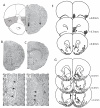
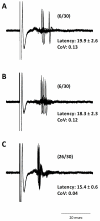
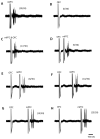
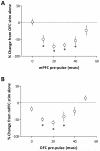
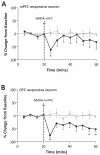
Similar articles
-
Prefrontal cortex inputs of the nucleus accumbens-nigro-thalamic circuit.Neuroscience. 1996 Mar;71(2):371-82. doi: 10.1016/0306-4522(95)00455-6. Neuroscience. 1996. PMID: 9053793
-
Timing-dependent regulation of evoked spiking in nucleus accumbens neurons by integration of limbic and prefrontal cortical inputs.J Neurophysiol. 2009 Apr;101(4):1823-35. doi: 10.1152/jn.91162.2008. Epub 2009 Feb 4. J Neurophysiol. 2009. PMID: 19193767 Free PMC article.
-
Critical role of the prefrontal cortex in the regulation of hippocampus-accumbens information flow.J Neurosci. 2008 Sep 24;28(39):9797-805. doi: 10.1523/JNEUROSCI.2200-08.2008. J Neurosci. 2008. PMID: 18815264 Free PMC article.
-
Localization of ionotropic glutamate receptors in caudate-putamen and nucleus accumbens septi of rat brain: comparison of NMDA, AMPA, and kainate receptors.Synapse. 1998 Oct;30(2):227-35. doi: 10.1002/(SICI)1098-2396(199810)30:2<227::AID-SYN13>3.0.CO;2-Z. Synapse. 1998. PMID: 9723793
-
Divergent plasticity of prefrontal cortex networks.Neuropsychopharmacology. 2008 Jan;33(1):42-55. doi: 10.1038/sj.npp.1301554. Epub 2007 Oct 3. Neuropsychopharmacology. 2008. PMID: 17912252 Free PMC article. Review.
Cited by
-
Molecular characteristics and laminar distribution of prefrontal neurons projecting to the mesolimbic system.Elife. 2022 Sep 5;11:e78813. doi: 10.7554/eLife.78813. Elife. 2022. PMID: 36063145 Free PMC article.
-
The medial orbitofrontal cortex governs reward-related circuits in an age-dependent manner.Cereb Cortex. 2023 Feb 20;33(5):1913-1924. doi: 10.1093/cercor/bhac182. Cereb Cortex. 2023. PMID: 35551358 Free PMC article.
-
Inhibitory Modulation of Orbitofrontal Cortex on Medial Prefrontal Cortex-Amygdala Information Flow.Cereb Cortex. 2018 Jan 1;28(1):1-8. doi: 10.1093/cercor/bhw342. Cereb Cortex. 2018. PMID: 29253248 Free PMC article.
-
Prefrontal cortex modulates desire and dread generated by nucleus accumbens glutamate disruption.Biol Psychiatry. 2013 Feb 15;73(4):360-70. doi: 10.1016/j.biopsych.2012.08.009. Epub 2012 Sep 13. Biol Psychiatry. 2013. PMID: 22981656 Free PMC article.
-
Glutamate concentration in the medial prefrontal cortex predicts resting-state cortical-subcortical functional connectivity in humans.PLoS One. 2013;8(4):e60312. doi: 10.1371/journal.pone.0060312. Epub 2013 Apr 3. PLoS One. 2013. PMID: 23573246 Free PMC article.
References
-
- Berendse HW, Galis-de Graaf Y, Groenewegen HJ. Topographical organization and relationship with ventral striatal compartments of prefrontal corticostriatal projections in the rat. Journal of Comparative Neurology. 1992;316(3):314–347. - PubMed
-
- Brog JS, Salyapongse A, Deutch AY, Zahm DS. The patterns of afferent innervation of the core and shell in the “accumbens” part of the rat ventral striatum: immunohistochemical detection of retrogradely transported fluoro-gold. Journal of Comparative Neurology. 1993;338(2):255–278. - PubMed
-
- Chakirova G, Welch KA, Moorhead TWJ, Stanfield AC, et al. Orbitofrontal morphology in people at high risk of developing schizophrenia. European Psychiatry. 2010;25(6):366–372. - PubMed
Publication types
MeSH terms
Substances
Grants and funding
LinkOut - more resources
Full Text Sources

